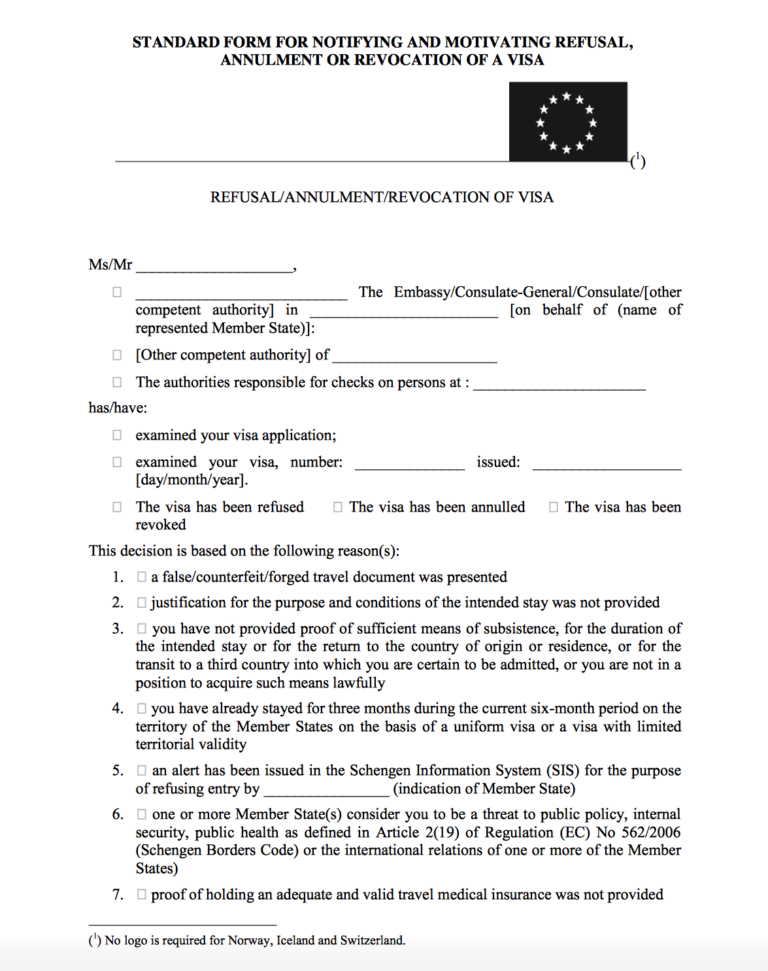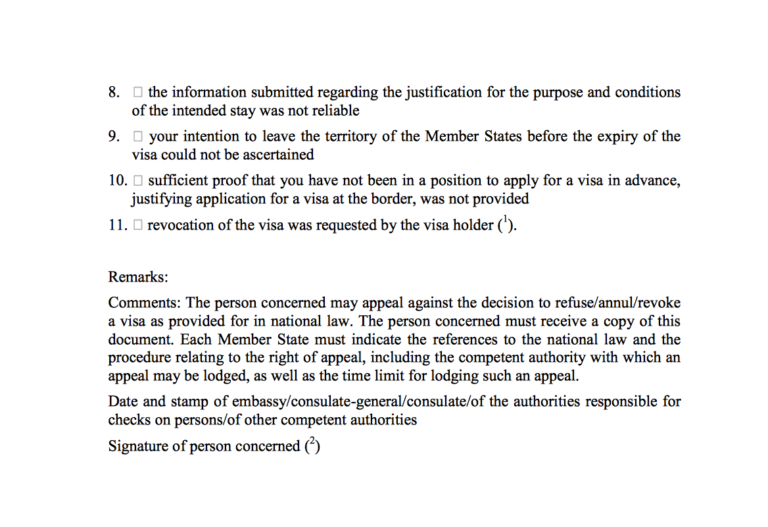
HOW TO WRITE AN APPEAL LETTER WHEN YOUR SCHENGEN VISA APPLICATION GETS REFUSED
Table of Contents
Introduction
Applying for a visa can be a complex and nerve-wracking, and receiving a visa refusal can be disheartening. However, all hope is not lost when your visa application gets rejected. In many cases, you have the option to appeal the decision by writing an appeal letter. In this blog post, we will guide you through how to write an effective appeal letter to give yourself the best chance of having your visa application reconsidered and approved.

What Is A Schengen Visa Application Refusal?
A Schengen Visa refusal is an official communication sent to visa applicants by a Schengen Embassy or Consulate, informing them that their visa application has been declined.
It’s important to note that a visa denial doesn’t imply a permanent ban from entering the Schengen Region. Rather, it signifies that your current application has not met the criteria for approval, and if you wish to travel to Europe, you must submit a fresh application. However, in certain cases, Schengen Embassies/Consulates may have compelling reasons to temporarily or permanently bar an individual from entering the Schengen Region. This typically occurs when an applicant has a problematic Schengen Visa history, such as not adhering to visa restrictions, a criminal background, or involvement in criminal activities within the Schengen Area.
Nevertheless, resubmitting an application after a denial doesn’t guarantee approval of the Schengen Visa. Your application can be either approved or rejected, irrespective of the new documents you provide.
Occasionally, when a Schengen Visa application is denied, the consular officer may send the applicant a rejection letter, outlining the specific reasons for the visa refusal. However, this is a rare occurrence. Typically, visa officers either reject the application outright or, at best, mark a checkbox corresponding to the reason for the visa rejection. Detailed explanations or additional information regarding the visa denial should be provided.
Important: It’s worth emphasizing that rejected applicants can address the issue by writing an appeal letter. However, this process is more complex. The appeal letter should be concise, limited to one page, and should be addressed to either the Embassy or the Ministry of Foreign Affairs of the Schengen State that rejected the visa or to other relevant EU institutions.
Common Reasons For Schengen Visa Rejection & Avoidance
Here, you will find the typical visa rejection letter, known as the “Standard form for communicating and providing reasons for visa refusal, annulment, and revocation of a visa,”


For further details regarding the explanations provided for each item as outlined in the “Standard form for communicating and providing reasons for visa refusal, annulment, and revocation of a visa,” please refer to this link.
What To Do When Your Visa Got Refused?
Step 1: Understand the Reason for Refusal
Before you begin drafting your appeal letter, it’s important to understand the specific reasons for your visa application’s refusal. The refusal letter you receive from the immigration authorities will typically provide detailed information on why your application was rejected. Common reasons for refusal include insufficient documentation, financial insufficiency, or concerns about the genuine travel intentions. I want you to know that understanding these reasons will help you address them in your appeal letter.
Step 2: Review the Visa Application Guidelines
Take the time to review the visa application guidelines and requirements carefully. Ensure that your appeal letter includes all the necessary information and documentation, such as a valid passport, proof of funds, travel itinerary, and any other specific documents required for your type of visa. Address any deficiencies or errors in your initial application to strengthen your appeal.
Step 3: Format and Tone
Your appeal letter should be written in a formal and respectful tone. Use professional language and avoid any emotional or confrontational language. Address the letter to the appropriate authority, usually the consulate or embassy that handled your initial application. Be concise and clear in your writing, focusing on the relevant information.
Step 4: Introduction
Begin your letter with a brief and polite introduction. State your name, passport number, and the date of your visa application. Express your gratitude for the opportunity to apply for a visa and your respect for the decision-making process.
Step 5: Explain the Reasons for Your Appeal
In the main body of your appeal letter, explain the reasons for your appeal. Address each point of refusal individually and provide a well-reasoned response. For instance, if your application was rejected due to financial insufficiency, explain any additional documentation or evidence you can provide to prove your financial stability. If there were concerns about the genuineness of your travel intentions, provide a clear and detailed explanation of your plans, including your ties to your home country.
Step 6: Provide Additional Supporting Documents
Include any additional supporting documents that strengthen your case. These may include bank statements, employment letters, invitation letters, travel itineraries, or any other relevant paperwork. Ensure that all documents are well-organized, clearly labeled, and easy for the reviewing officer to understand.
Step 7: Express Your Sincerity
In your conclusion, reiterate your sincere desire to visit the destination country and follow all visa regulations. Express your hope that the immigration authorities will reconsider your application favorably. Thank them for their time and consideration.
Step 8: Proofread and Edit
Before sending your appeal letter, carefully proofread and edit it for grammar, spelling, and formatting errors. A well-written and error-free letter demonstrates professionalism and attention to detail.
Step 9: Submit Your Appeal
Follow the instructions provided in your refusal letter regarding the submission of your appeal. This may involve sending your appeal letter and supporting documents to a specific address or email address. Make sure to include a copy of your original refusal letter and any reference numbers.
Step 10: Be Patient and Follow Up
Once you have submitted your appeal, be patient. The review process may take some time, and it’s essential to remain calm and wait for a response. If you haven’t heard back within a reasonable timeframe, consider following up with the consulate or embassy to inquire about the status of your appeal.
Final Thoughts
Facing a visa refusal can be a frustrating experience, but writing an appeal letter gives you a chance to address the reasons for the refusal and present a stronger case. By following the steps outlined in this guide, you can increase your chances of having your visa application reconsidered and approved. Remember to be thorough, respectful, and patient throughout the process, and you may find yourself packing your bags for your desired destination sooner than you think.
Recap and Tips
So, just a recap and a reminder, please don’t forget these TIPS:

If you ever need help, you can avail my visa application bundle, and I will be glad to help you through the process!
Let Us Be Your Partner in Your Schengen Visa Journey
Applying for a Schengen Visa can be overwhelming, with all the paperwork involved and confusing information from different sources. We understand that—we’ve been there and have done that!
But through the years, we gained experience and knowledge on the ins and outs of the Schengen Visa application. We’ve helped countless satisfied clients; we would like to invite you to be one of them!
With our Schengen Visa services personalized to your unique needs and circumstances, we will make your visa application less stressful and laborious and more promising. Contact us to schedule a consultation or for other inquiries.
